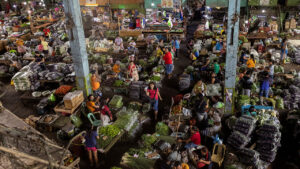




Quarterly Economic Growth Release: More BSP cuts to come
 DOWNLOAD
DOWNLOAD

Monthly Economic Update: Fed catches up
 DOWNLOAD
DOWNLOAD

Inflation Update: Steady and mellow
 DOWNLOAD
DOWNLOAD


World Bank lowers PH growth forecast

THE WORLD BANK downgraded its growth forecast for the Philippines this year, as high inflation weighs on consumption.
In its East Asia and the Pacific Economic Update report released on Friday, the multilateral lender trimmed its gross domestic product (GDP) growth projection to 5.6% from the 5.8% forecast given in October.
This is below the government’s 6-7% growth target for the year, and the 7.6% expansion in 2022.
World Bank Chief Economist for East Asia & Pacific Aaditya Mattoo said at a virtual briefing on Friday said the country needs to address supply constraints in its fight against inflation.
“Philippines faces the problem of elevated inflation and its inflation was higher than 8%. It has increased significantly. It needs to address domestic food supply constraints,” Mr. Mattoo said.
Philippine headline inflation slowed to 8.6% in February from a 14-year high of 8.7% in January. For the first two months of the year, inflation averaged 8.6%.
To curb inflation, the central bank has raised borrowing costs by 425 basis points (bps) since May last year. This brought the benchmark rate to 6.25% — the highest in nearly 16 years.
Mr. Mattoo said Philippine economic growth will still be driven by domestic demand, an increase in private investments due to recent reforms, and sustained growth in public investment.
A boost in the country’s tourism sector may also help soften the impact of slowing export growth amid weakening global demand, he said.
In terms of fiscal consolidation, Mr. Mattoo said the Philippines should exert greater effort in improving tax policy and administration.
“The Philippines is one country which really suffered a lot from what happened during the pandemic to human capital,” he said, adding that the country still has high levels of learning poverty even though it provides skilled professionals to other parts of the world.
He also noted the manufacturing sector has been steadily declining in the recent years while other countries in the region saw an increase.
“So how it can consolidate and deepen its strengths through creating more stronger human capital, as well as finding ways to try and actually stimulate its manufacturing sector, are the two big challenges in the country,” Mr. Mattoo said.
In the report, the World Bank projects the East Asia and the Pacific region to grow to 5.1% in 2023 from 3.5% in 2022. This was higher than the 4.6% forecast in October.
Countries in developing East Asia and the Pacific include the Philippines, Vietnam, Malaysia, Indonesia, Thailand and Mongolia, as well as island nations like Fiji, Vanuatu and Palau.
The higher growth is mostly due to China’s economic reopening, where gross domestic product (GDP) growth is seen to rebound to 5.1% this year from 3% in 2022.
Excluding China, growth in the rest of the region is seen to slow to 4.9% in 2023 from 5.8% last year as high inflation will likely dampen private consumption.
“Most major economies of East Asia and the Pacific have come through the difficulties of the pandemic but must now navigate a changed global landscape,” World Bank East Asia and Pacific Vice President Manuela V. Ferro said in a statement.
“To regain momentum, there is work left to do to boost innovation, productivity, and to set the foundations for a greener recovery.”
High household debt in some countries in the region could also add to the impact of high interest rates, further weighing on consumption, the Washington-based lender said.
Investment growth may also be affected due to elevated borrowing costs, while exports are expected to decline in the region amid slowing external demand. – By Keisha B. Ta-asan
This article originally appeared on bworldonline.com





 By BusinessWorld
By BusinessWorld